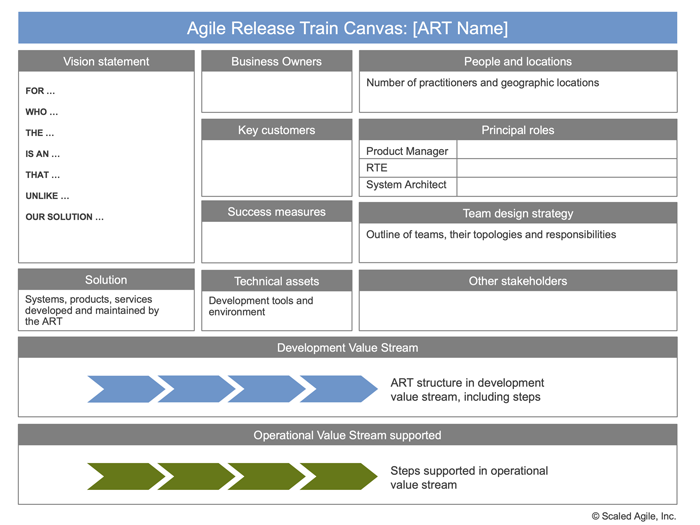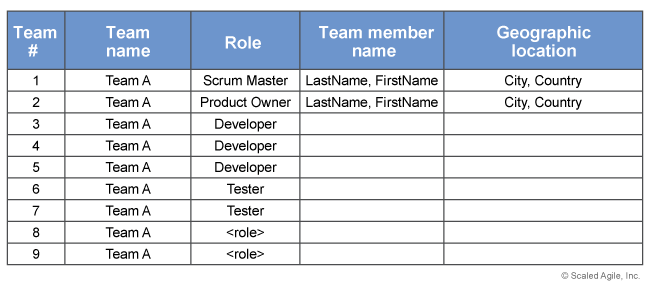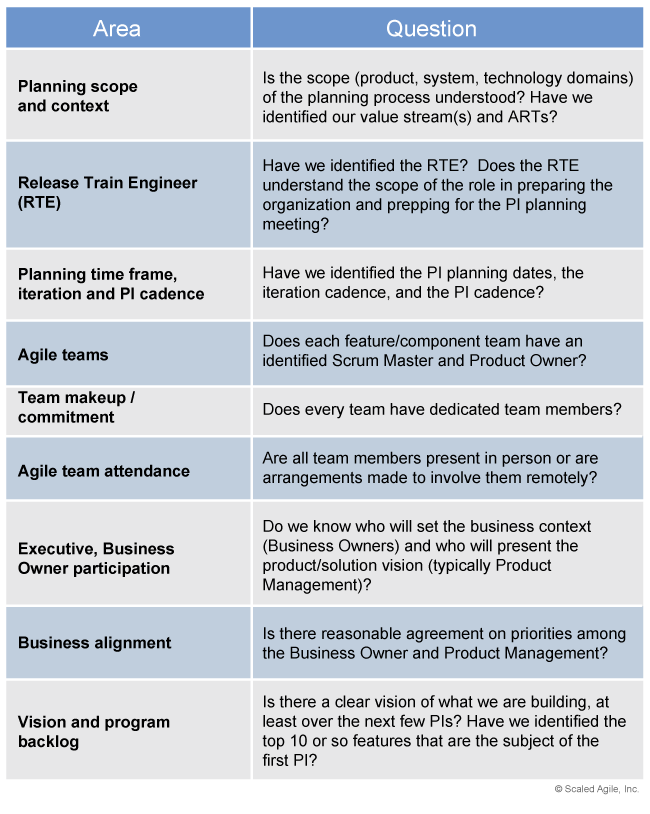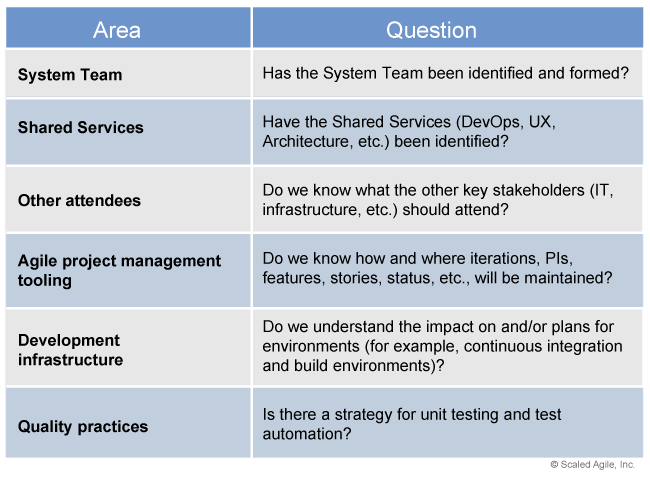In this blog series, we are taking a quick look at each of the 12 steps in the SAFe Implementation Roadmap. Now that the team has identified all of their Value Streams and Agile Release Trains (ARTs) and created the implementation plan, it’s time to prepare for the first ART launch.
According to the SAFe website, the steps used to prepare for the first ART launch generally include:
- Define the ART (done in the previous step)
- Set the launch date and cadence of the program calendar
- Train ART leaders and stakeholders
- Establish the Agile teams
- Train Product Managers and Product Owners (POs)
- Train Scrum Masters
- Train System Architects/Engineers
- Assess and evolve launch readiness
- Prepare the program backlog
We will dig a bit deeper into each step in the sections below.
Define the ART
In part 3 of this series, we talked about identifying value streams and ARTs. If you missed this vital step, please give it a quick read before continuing with this section.
As mentioned earlier, part 4 of this series gives you tips on how to create your implementation plan. In this step, we defined the ART just enough to know that it, in fact, is an ART. Since our SAFe Agile Practitioners (SPCs) team comprises leaders from multiple disciplines within the organization, we will need people with more focused experience to clearly define the details in their ART. The suggested “canvas” from the Scaled Agile website is below:
One of the most valuable points to this canvas is that it helps identify who does what in the ART. For the system to function well, everybody in the team needs to understand their responsibilities. By working with more “localized” stakeholders, those that actively participate in the ART regularly, all parts of the solution will have an owner.
Set the Launch Date and Cadence of the Program Calendar
Some people don’t like to work with deadlines, but from our experience, setting dates on calendars works well in motivating teams to get work done. If you can select a due date with all the ART stakeholders, the team will benefit greatly.
Beyond this, establishing the cadence for your program increments (PIs) will be necessary. You will start to realize this and get a better idea of the length as you start speaking with stakeholders inside an ART. Typically, a program increment lasts from 8-12 weeks. On the SAFe website, they have a ten-week PI which contains four regular iterations and one Innovation and Planning iteration. There is no set rule for the length of a PI, but once the length is chosen, it should stay the same so that the team can establish their cadence.
The fixed PI length also allows members to see what’s coming in the immediate and long-term future. The cadence and events have a lot of similarities to Scrum. In SAFe, a typical program increment has the following events:
- PI Planning (similar to Sprint Planning)
- System Demos (similar to a Sprint Review)
- ART Sync or individual Scrum of Scrum and PO sync events (similar to a standup)
- Inspect and Adapt (I&A) workshops (similar to a retrospective)
These are significant events, similar to planning, review, standup, and retrospective meetings in Scrum. Having them on the calendar ahead of time allows teams to schedule their iteration events accordingly. It also allows key PI members to geolocate for the necessary in-person meetings.
Train ART Leaders and Stakeholders
People are busy. Ideally, the SPCs would have already trained all the individual ART leaders and stakeholders. However, this is highly unlikely. If the leaders of the specific ART that you are focusing on haven’t had the training, it makes sense to do it now. The leaders could be anyone from architects to business owners or even operators. Shortly after this training, we will usually dive right into the implementation. This is because the training and principles are fresh for the leaders, and getting their initial thoughts and perspectives on their ART ensures the best outcome.
Establish the Agile Teams
SAFe, much like other frameworks and systems, is highly dependent on the people and teams that work within them. You can have the best framework set up with value-driven ARTs, but if your teams work completely siloed, your ART will fail.
Establishing the teams within the ART can happen in two ways. The first way is we allow the members of the ART to form Agile teams themselves. The other way is by using the organization’s management to make the teams based on the different talent within the ART. The members of the agile teams will have a good understanding of the way they like to work. After all, they have likely been in their roles for some time. The management will help guide the team decisions according to individual, organizational, and product development strategies.
In the end, before any PI planning happens, all members must be part of an Agile Team. They must also establish Product Owner and Scrum Master roles. Here is an example of a team roster from the Scaled Agile website:
As you go about completing your roster, you will make some interesting discoveries. It might be that a person is working with more than one team, which is an absolute non-starter in Agile. You also might start to notice the disbursement of team members across many geographical locations. Collocation is ideal, but if team members are located in different time zones, that is also acceptable. Once the team is established, members start to recognize when team events like retrospectives and daily standups will be.
Train Product Managers, Product Owners (POs), Scrum Masters, and System Architects/Engineers
People working in product, Product Managers, Product Owners, and Product Marketers all need SAFe training. This role is critical in tech companies because these people end up driving the product’s direction. These members need to be trained to enhance collaboration, learn the new way of working, and how to fulfill their responsibilities best.
Training Scrum Masters is an entirely different animal. SAFe relies heavily on the servant-leadership of the Scrum Master. They will spend most of their time coaching the various team members on how to work more efficiently. The real value of scrum masters shines through in PI planning. This is because they will help facilitate value-driven delivery in these meetings. They must be trained before this.
Lastly, we must train the engineers and architects within the team. They are going to drive your technological and architectural development. They must be trained on the best ways of collaborating and helping the stakeholders make the best decisions for your organization’s solutions.
Assess and Evolve Launch Readiness
Training is merely one part of getting ready for ART launch. There is no perfect “ready” state, but some degree of readiness is required. The following two images from the SAFe website can serve as your checklist for assessing whether you and your team are ready or not.
According to SAFe experts, the items in the first image are mainly required for a successful ART launch. The items in the second image are more like “nice to have” features.
Prepare the Program Backlog
The program backlog will be the central location for all of your program increments (PIs). The backlog will contain a list of features, NFRs, and architectural work that define the future state of your solution. Scaled Agile Consultants (SPCs) and Lean-Agile Center of Excellence (LACE) members will often bring stakeholders from the different ARTs together to determine the backlog. Key members will not be able to complete this activity in one meeting or even in one afternoon. This can be a long process, depending on how opinions differ.
From our experience working with SAFe teams, we recommend not getting too involved in the nuts and bolts of each PI. Usually, a feature list with straightforward acceptance criteria is sufficient to get started. After all, it’s the individual agile teams that will know the best way to implement these features.
Don't miss out on the previous parts of the SAFe Implementation Roadmap series!
Part 1: Getting started and reaching the tipping point
Part 2: Train lean-agile change agents
Part 3: Identify Value Streams and Agile Release Trains
Part 4: Create the implementation plan
Learn more about SAFe and Agile Hive: SAFe in Jira
If you are curious about learning more about SAFe or the software-supported implementation of SAFe, ask us about Agile Hive! We would be happy to discuss your requirements for enterprise-wide agile product development and product management with you. Take a look at our Implementation Project documentation to see an overview of what an implementation would entail.
Get in touch with us today, and let us demonstrate how it works in a personal session.
Further Reading
- Agile Hive Implementation Project
- Scaled Agile: SAFe 5.0 changes and how Agile Hive maps them
- SAFe with Atlassian tools: Agile Hive is a Scaled Agile Platform Partner
- SAFe resources to get you started right
- Agile Hive: What is SAFe®?
Learn more about Creative Commons licensing and //Seibert/Media







